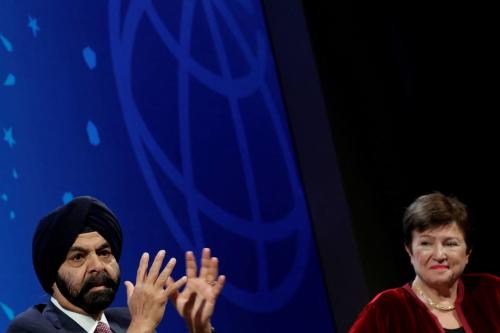On Wednesday, August 28th, the government of Argentina announced it would seek a “voluntary reprofiling” of its debt. The International Monetary Fund’s (IMF) July 2019 report on Argentina shows an increase in public debt-to-GDP from 57 percent at the end of 2017 to 86 percent in 2018 mostly because of currency depreciation. Primary fiscal balances have moved from a surplus of 3.8 percent of GDP during 2008-2016 into significant deficit. Growth projections are anemic and bond spreads rose to over 2000 basis points after the debt reprofiling was announced. Over the weekend, Argentina imposed currency controls to shore up the peso and protect its depleted foreign exchange reserves. This could be bad news if such controls translate into an implicit tax on agricultural and manufacturing exports should a parallel foreign exchange market develop.
The crises in Russia (1998), Argentina (2001), and Greece (2010-2016) provide at least five valuable lessons, with similar mistakes made in IMF-led rescues.
The first lesson is that voluntary debt reprofilings are at best neutral when concerns about solvency exist. Private creditors will not voluntarily accept a reduction in the net present value of government debt. At worst, such reprofiling can backfire as private creditors extract a heavy price for it. Russia’s July 1998 swap from ruble treasury bills (GKOs) into dollar-denominated eurobonds resulted in a significant quantity of dollar debt at a default-level spread of 940 basis points being dumped onto the market. This triggered margin calls on the big Moscow banks by lowering the prices of the existing dollar government debt in their portfolios. They met these calls by selling their GKOs and converting the proceeds into dollars, depleting the central bank’s reserves and forcing the devaluation and default of August 17, 1998.
Similarly, Argentina’s “megacanje” (mega-swap) of June 2001, which tried to lengthen the maturity of its dollar-denominated debt, was achieved at a spread of 1100 basis points. Michael Mussa, then the chief economist of the IMF, noted in his scathing 2002 post-mortem, that Argentina’s debt dynamics were “virtually hopeless” at spreads greater than 1000 basis points. He also described the IMF’s extension of additional financing in the summer of 2001 as an “important mistake” because it was clear by then that avoiding a “default and maintain[ing] the exchange rate peg had no reasonable chance of success.” That December, Argentina defaulted and abandoned the hard peg of its peso to the dollar.
The second lesson is to avoid large upfront financing packages from official sources like the IMF when fiscal solvency concerns are present. Such loans are typically perceived as senior and offer the perfect moment—via the enhancement of liquidity— for private creditors to exit, triggering a collapse and leading to a replacement with official debt that is much harder to restructure. This result was most visible in Russia 1998 and Greece 2010-2012.
The third lesson is that the bargaining power of the IMF and official sector vis-à-vis the country’s private creditors is maximum at the onset of a crisis. If official money is disbursed before an exchange rate adjustment or without an upfront haircut for private creditors, a smaller pool of private debt is left. Private creditors who exit when the official money arrives benefit at the expense of those left behind. And since official debt cannot be easily restructured, a much larger fiscal adjustment is needed to place government debt on a sustainable path.
The fourth lesson is that market signals must be taken seriously. If bonds are being priced at default levels and there is a persistent run on foreign exchange reserves, hard questions arise: Is there a reasonable path for achieving sufficiently high primary fiscal surpluses and economic growth to lower interest rates and restore confidence? Is the exchange rate sustainable? Are banks vulnerable? Or: Is a debt write-down unavoidable? If the answer to the latter is “yes,” it would be a serious mistake to bring in even more official money or orchestrate a voluntary, market-based debt reprofiling. Such “gambles for resurrection” fared badly in Russia 1998, Argentina 2001, and Greece 2010-2016.
The fifth lesson, best illustrated by Greece, is that procrastination is costly. By March 2010, Greece needed a bailout. But the European Union-European Central Bank-IMF troika ruled out any haircut for Greece’s private creditors until 2012. As Olivier Blanchard, the then chief economist of the IMF, put it in 2015, “Debt restructuring was delayed by two years [owing to] concerns about contagion risk…. and the lack of firewalls to deal with contagion.” But contagion eventually spread to Italy and Spain, prompting Draghi’s famous July 2012 statement that the European Central Bank would do “whatever it takes” to keep the eurozone together. Only in 2016 when a third bailout was needed did the IMF refuse to participate without “upfront, unconditional” debt relief—six years too late. Greece paid a heavy price.
There is, sadly, a sixth lesson. Even though procrastination is costly, orderly sovereign debt restructurings are elusive, dating to at least the 1980s debt crisis in Latin America.
The priority in Argentina should be to protect vulnerable groups in society as they will surely bear the brunt of this new crisis. On the macroeconomic front, the IMF has already disbursed some $44 billion out of the $50 billion Stand-By Arrangement approved in June 2018, upped to $57 billion in September 2018 as the peso came under attack. This complicates the situation considerably should Argentina’s debts prove unsustainable. Ultimately, Argentina must fix its own economic problems. It will have far greater incentive to do so the harder the budget constraint it faces. Russia was cut off from the capital markets, domestic and foreign, after its August 1998 default, forcing the government to reform. Five years later, its debt was rated investment grade. Clear-headed thinking is needed on the balance between haircuts and fiscal and structural reforms on the one hand and new money on the other as Argentina’s latest crisis deepens.





Commentary
Argentina 2019: The IMF should avoid mistakes repeatedly made in past bailouts
September 5, 2019